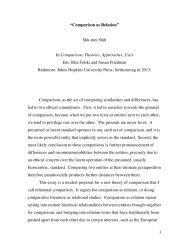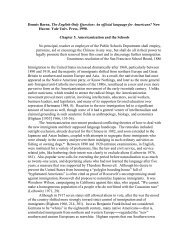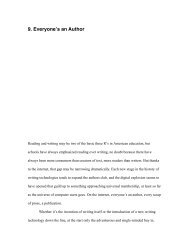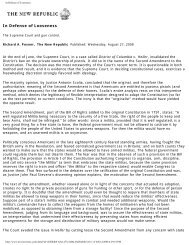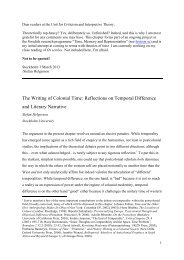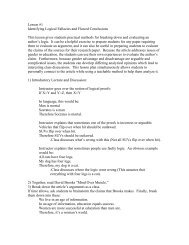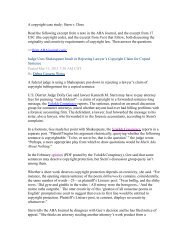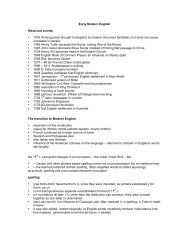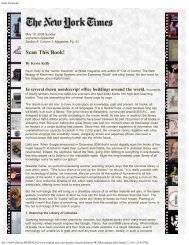Technics of the Subject: The Avatar-Drive Emily Apter - English
Technics of the Subject: The Avatar-Drive Emily Apter - English
Technics of the Subject: The Avatar-Drive Emily Apter - English
Create successful ePaper yourself
Turn your PDF publications into a flip-book with our unique Google optimized e-Paper software.
<strong>the</strong>ories <strong>of</strong> <strong>the</strong> subject imbued with what French sociologist Georges Friedmann dubs "<strong>the</strong><br />
technical milieu."3 A specialist <strong>of</strong> factory life and subjective submission to <strong>the</strong> technical<br />
environment, Friedmann stands alongside Raymond Ruyer and Gilbert Simondon (especially<br />
important in conceptualizing a hylomorphic understanding <strong>of</strong> <strong>the</strong> human as ontologically utensil,<br />
as well as a somato-psychic <strong>the</strong>ory <strong>of</strong> <strong>the</strong> existence-mode <strong>of</strong> objects) among <strong>the</strong> precursors <strong>of</strong><br />
Deleuze and Guattari who toge<strong>the</strong>r most significantly articulated philosophies <strong>of</strong> machinic<br />
expressionism and virtual ontology.4 As a set <strong>of</strong> thinkers, <strong>the</strong>y join Freud and Lacan––<strong>the</strong><br />
founders <strong>of</strong> analytic technique, and Heidegger, <strong>the</strong> premier <strong>the</strong>orist <strong>of</strong> technè and Bestand<br />
("standing-reserve," by which he refers to nature's latent capacity to be technologically entrained<br />
by man), in setting <strong>the</strong> terms <strong>of</strong> subject technics. <strong>The</strong> work <strong>of</strong> Bernard Stiegler is also especially<br />
germane; his La Technique et le temps 1, La faute d'Epiméthée [<strong>Technics</strong> and Time: <strong>The</strong> Fault <strong>of</strong><br />
Epime<strong>the</strong>us] examines <strong>the</strong> sophistic devaluation <strong>of</strong> technè in <strong>the</strong> history <strong>of</strong> philosophy, tracing its<br />
retrieval and gradual fusion with epistemè in Enlightenment modernity. Aristotelian distinctions<br />
between nature and technology thus give way to <strong>the</strong> "technicized life," engendered through<br />
biopower, genetic and social engineering (education, marketing), "psychotechnics" (cognitive<br />
technologies), "phenomenotechnics" (technologies <strong>of</strong> memory, consciousness, individuation),<br />
and <strong>the</strong> noosphere <strong>of</strong> "psychopower" (<strong>the</strong> program <strong>of</strong> a new human under conditions <strong>of</strong><br />
evolutionary complexity, cyberspatial orders <strong>of</strong> cognition) (276).5<br />
<strong>Technics</strong> is <strong>of</strong> course a neologism in <strong>English</strong> and is adapted here from Samuel Weber's<br />
translation <strong>of</strong> Heidegger's Technik. "Technology" and "Technique," according to Weber, are<br />
inadequate <strong>English</strong> equivalents because <strong>the</strong>y fail to convey <strong>the</strong> range <strong>of</strong> associations subsumed in<br />
Heidegger's usage, which include knowledge, craft, skill, <strong>the</strong> placing <strong>of</strong> orders (stock and trade<br />
orders, military commands), poeisis, and art (51-72). Arguably, Heidegger's "Questions<br />
Concerning Technology" [alternately translated as "Questing After <strong>Technics</strong>"] sits at <strong>the</strong> fulcrum<br />
<strong>of</strong> a burgeoning "technics <strong>the</strong>ory" bibliography comprising Gilbert Simondon's Du Mode<br />
d'existence des objets techniques, Bernard Stiegler's Time and <strong>Technics</strong>, Derrida and Stiegler's<br />
Echograhies, Friedrich Kittler's Network Systems and essays in Literature, Media, Information<br />
Systems, Samuel Weber's Mass Mediaurus and Targets <strong>of</strong> Opportunity, Brian Massumi's<br />
Parables <strong>of</strong> <strong>the</strong> Virtual: Movement, Affect, Sensation, Avital Ronell's <strong>The</strong> Test <strong>Drive</strong>, Alexander<br />
Galloway's Gaming: Essays on Algorithmic Culture, McKenzie Wark's Gamer <strong>The</strong>ory and<br />
Eugene Thacker's Biomedia. What distinguishes <strong>the</strong>se works from a host <strong>of</strong> o<strong>the</strong>r titles at <strong>the</strong><br />
juncture <strong>of</strong> philosophy and media <strong>the</strong>ory is <strong>the</strong>ir default to techne as conceptually constitutive <strong>of</strong><br />
thought, being, and agency.<br />
<strong>Subject</strong> technics also redounds to an earlier history <strong>of</strong> systems <strong>the</strong>ory and cybernetics that<br />
flourished across disciplines during <strong>the</strong> Cold War. <strong>The</strong> short list <strong>of</strong> references includes Talcott<br />
Parsons (whose <strong>The</strong> Social System, a foundational work in social <strong>the</strong>ory, appeared in 1951),<br />
Ludwig von Bertalanffy, Warren McCulloch (celebrated for ma<strong>the</strong>matical modeling <strong>of</strong> neural<br />
networks), Claude Shannon, Norbert Wiener, and John von Neumann (<strong>the</strong> legendary inventors <strong>of</strong><br />
information <strong>the</strong>ory, cybernetics, game <strong>the</strong>ory, quantum mechanics). It is also important to<br />
mention <strong>the</strong> engineer Jay Forrester, who introduced core memory and random access magnetic<br />
storage in computing and extended systems <strong>the</strong>ory to "world dynamics" using bi<strong>of</strong>eedback<br />
models to examine <strong>the</strong> organization <strong>of</strong> industries, cities, and environmental situations. <strong>The</strong> idea<br />
<strong>of</strong> <strong>the</strong> "open system" emphasizes ways in which systems, interacting with <strong>the</strong> environment,<br />
evolve into new hierarchical structures <strong>of</strong> organization, and was applied in <strong>the</strong> fifties and sixties<br />
2


